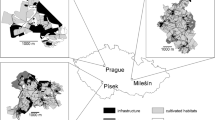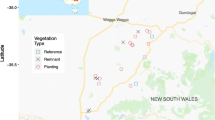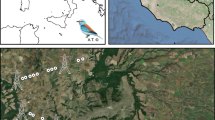Abstract
Reed passerine birds are strict habitat specialists inhabiting reedbed habitats. In Europe, many of these species are threatened due to loss and degradation of natural reedbeds. Another important factor that can negatively affect the abundance of reed passerines is commercial reed harvesting. Previous studies have shown negative impacts of large-scale winter reed cutting on passerine breeding assemblages and arthropod communities. The effect of reed cutting on a small scale, however, has not been studied experimentally to date. The aim of this study was to investigate whether and how small-scale, mosaic reed cutting influences prey abundance and nest predation rate of reed passerines. In June, after the reed had reached maturity, we conducted nest predation experiments with artificial nests and arthropod sampling using pan traps in cut reed patches, adjacent uncut reed patches and unmanaged reedbed. We found no differences in the risk of egg predation between three types of reedbeds. In contrast, the abundance of arthropods in cut and adjacent uncut reed patches was significantly higher than that in unmanaged reedbed. We assume this was caused by habitat heterogeneity, small size of cut patches and their rapid recolonization by arthropods from adjacent uncut patches. Our results suggest that in contrast to large-scale reed cutting, small-scale, mosaic reed cutting has no negative effect on nest survival and food abundance of reed passerine birds. However, given that we performed all experiments in June, i.e., when the reed was mature, our findings cannot be generalized to whole breeding period of all reed passerine birds. Therefore, temporal variation in nest predation rate and arthropod abundance in managed and unmanaged reedbeds during the entire breeding season should be examined in future studies.
Similar content being viewed by others
References
Báldi A, Batáry P (2005) Nest predation in European reedbeds: different losses in edges but similar losses in interiors. Folia Zool 54:285–292
Batáry P, Báldi A (2004) Evidence of an edge effect on avian nest success. Conserv Biol 18:389–400
Batáry P, Báldi A (2005) Factors affecting the survival of real and artificial great reed warbler’s nests. Biologia 60:215–219
Batáry P, Winkler H, Báldi A (2004) Experiments with artificial nests on predation in reed habitats. J Ornithol 145:59–63
Bender DJ, Contreras TA, Fahring L (1998) Habitat loss and population decline: a meta-analysis of the patch size effect. Ecology 79:517–533
Bensch S, Hasselquist D (1994) Higher rate of nest loss among primary than secondary females: infanticide in the great reed warbler? Behav Ecol Sociobiol 35:309–317
Duelli P, Obrist MK, Schmatz DR (1999) Biodiversity evaluation in agricultural landscapes: above-ground insects. Agr Ecosyst Environ 74:33–64
Faaborg J (2004) Truly artificial nest studies. Conserv Biol 18:369–370
Gajdoš P, David S, Petrovič F et al (2005) The National Nature Reserve (NNR) of the Parížske močiare (landscape, biodiversity and nature protection). Bratislava, Banská Bystrica, Nitra. (In Slovak with English summary)
Graveland J (1999) Effects of reed cutting on density and breeding success of reed warbler Acrocephalus scirpaceus and sedge warbler Acrocephalus schoenobaenus. J Avian Biol 30:469–482
Grim T, Honza M (1996) Effect of habitat on the diet of reed warbler (Acrocephalus scirpaceus) nestlings. Folia Zool 45:31–34
Hansson B, Bensch S, Hasselquist D (2000) Patterns of nest predation contribute to polygyny in the great reed warbler. Ecology 81:319–328
Hoi H, Winkler H (1994) Predation on nests: a case of apparent competition. Oecologia 87:436–440
Hoi H, Darolová A, Krištofík J (2001) Factors influencing nest depredation in European Reed Passerines. In: Hoi H (ed) The ecology of reed birds. Österreichische Academie der Wissenschaften, Wien, pp 27–36
Honza M, Øien IJ, Moksnes A, Roskaft E (1998) Survival of reed warbler Acrocephalus scirpaceus clutches in relation to nest position. Bird Study 45:104–108
Ille R, Hoi H, Kleindorfer S (1996) Brood predation, habitat characteristics and nesting decisions in Acrocephalus scirpaceus and A. palustris. Biologia 51:219–225
Leisler B, Schultze-Hagen K (2011) The reed warblers: diversity in a uniform bird family. KNNV, Zeist
Martin TE (1993) Nest predation and nest sites: new perspectives and old patterns. Bioscience 43:523–532
Martínez-Vilalta J, Bertolero A, Bigas D, Paquet JY, Martínez-Vilalta A (2002) Habitat selection of passerine birds nesting in the Ebro Delta reedbeds (NE Spain): management implications. Wetlands 22:318–325
Mitsch WJ, Gosselink JG (2000) Wetlands, 3rd edn. Wiley, New York
Moore RP, Robinson WD (2004) Artificial bird nests, external validity, and bias in ecological field studies. Ecology 85:1562–1567
Poulin B, Lefebvre G (2002) Effect of winter cutting on the passerine breeding assemblage in French Mediterranean reedbeds. Biodivers Conserv 11:1567–1581
Poulin B, Lefebvre G, Mauchamp A (2002) Habitat requirements of passerines and reedbed management in southern France. Biol Conserv 107:315–325
Purger JJ, Kurucz K, Tóth A, Batáry P (2012) Coating plasticine eggs can eliminate the overestimation of predation on artificial ground nests. Bird Study 59:350–352
Reitsma LA, Holmes RT, Sherly TW (1990) Effects of removal of red squirrels, Tamiasciurus hudsonicus, and eastern chipmunks, Tamias striatus, on nest predation in a northern hardwood forest: an artificial nest experiment. Oikos 57:375–380
Roos S (2002) Functional response, seasonal decline and landscape differences in nest predation risk. Oecologia 133:608–615
Schiegg K, Eger M, Pasinelli G (2007) Nest predation in reed buntings Emberiza schoeniclus: an experimental study. Ibis 149:365–373
Schmidt MH, Lefebvre G, Poulin B, Tscharntke T (2005) Reed cutting affects arthropod communities, potentially reducing food for passerine birds. Biol Conserv 121:157–166
Schulze K, Leisler B, Winkler H (1996) Breeding success and reproductive strategies of two Acrocephalus warblers. J Ornithol 137:181–192
Swanson L, Sanyaolu RA, Gnoske T, Whelan CJ, Lonsdorf EV, Cordeiro NJ (2012) Differential response of nest predators to the presence of a decoy parent in artificial nests. Bird Study 59:96–101
Thompson FR, Burhans DE (2004) Differences in predators of artificial and real songbird nests: evidence of bias in artificial nest studies. Conserv Biol 18:373–380
Trnka A (1995) Dietary habits of the great reed warbler (Acrocephalus arundinaceus) young. Biologia 50:507–512
Trnka A, Prokop P (2006) Reedbed structure and habitat preference of reed passerines during the post-breeding period. Biologia 61:225–230
Trnka A, Prokop P (2007) Impact of winter reedbeds cutting on passerine breeding success in the Parížske močiare National Nature Reserve. Tichodroma 19:143–147 (In Slovak with English summary)
Trnka A, Prokop P (2011) The use and function of snake skins in the nests of great geed warblers Acrocephalus arundinaceus. Ibis 153:627–630
Trnka A, Čapek M, Kloubec B (2003) Birds of the National Nature Reserve Parížske močiare marsh (SW Slovakia). Veda, Bratislava. (In Slovak with English summary)
Trnka A, Prokop P, Batáry P (2008) Dummy birds in artificial nest studies: an experimental with red-backed shrike Lanius collurio. Bird Study 55:329–331
Trnka A, Batáry P, Prokop P (2009) Interacting effects of vegetation structure and breeding patterns on the survival of great reed warbler Acrocephalus arundinaceus nests. Ardea 97:109–116
Trnka A, Prokop P, Batáry P (2010) Infanticide or interference: does the great reed warbler selectively destroy eggs? Ann Zool Fenn 47:272–277
Trnka A, Peterková V, Grujbárová Z (2011) Does reed bunting (Emberiza schoeniclus) predict the risk of nest predation when choosing a breeding territory? An experimental study. Ornis Fennica 88:179–184
Vadász C, Német Á, Biró C, Csörgő T (2008) The effect of reed cutting on the abundance and diversity of breeding passerines. Acta Zool Acad Sci H 54:177–188
Valkama E, Lyytinen S, Koricheva J (2008) The impact of reed management on wildlife: a meta-analytical review of European studies. Biol Conserv 141:364–374
Weidinger K (2002) Interactive effects of concealment, parental behaviour and predators on the survival of open passerine nests. J Anim Ecol 71:424–437
Whittingham MJ, Evans KL (2004) The effects of habitat structure on predation risk of birds in agricultural landscapes. Ibis 146:210–220
Zanette L (2002) What do artificial nests tells us about nest predation? Biol Conserv 103:323–329
Acknowledgments
We thank F. Hrdlovič, J. Medveď, M. Medveď and B. Trnková for their invaluable assistance in the field, M. Zatko and master students for helping make artificial nests and pan traps and L. Sutcliffe for linguistic revision. The comments of two referees substantially improved the manuscript. The study was conducted in compliance with the law of Slovakia. Licence to perform experiments was provided by the Ministry of Environment of Slovak Republic. This work was supported by the Slovak Grant Agency for Science (VEGA), project No. 1/3257/06. During the preparation of the paper, P. B. was supported by the German Research Foundation (DFG BA 4438/1-1).
Author information
Authors and Affiliations
Corresponding author
Electronic supplementary material
Below is the link to the electronic supplementary material.
11273_2013_9325_MOESM1_ESM.tif
Location of study plots in the study area. Each dot represents one study plot. Yellow dots represent study plots located in cut reed patches, green dots represent study plots located in adjacent uncut reed patches and brown dots represent study plots located in unmanaged reedbed. Supplementary material 1 (TIFF 1880 kb)
Rights and permissions
About this article
Cite this article
Trnka, A., Peterková, V., Prokop, P. et al. Management of reedbeds: mosaic reed cutting does not affect prey abundance and nest predation rate of reed passerine birds. Wetlands Ecol Manage 22, 227–234 (2014). https://doi.org/10.1007/s11273-013-9325-3
Received:
Accepted:
Published:
Issue Date:
DOI: https://doi.org/10.1007/s11273-013-9325-3




